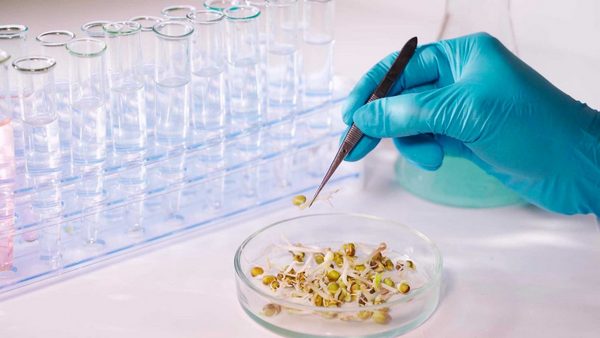Material World – Why biodiversity matters
 Biodiversity is vitally important to human society and human survival – not just the biodiversity of the wilderness but also the agrobiodiversity of domesticated plants and animals. One has to be constantly wary of the risk to such biodiversity posed by genetic erosion and species loss. These work to shrink the genetic pool – the natural variability of organisms – that breeders rely upon to select the kind of varieties they want to develop. That then reduces their room for manoeuvre. It makes agricultural output increasingly vulnerable to the effects of climate change and the emergence of new diseases or pests.
Biodiversity is vitally important to human society and human survival – not just the biodiversity of the wilderness but also the agrobiodiversity of domesticated plants and animals. One has to be constantly wary of the risk to such biodiversity posed by genetic erosion and species loss. These work to shrink the genetic pool – the natural variability of organisms – that breeders rely upon to select the kind of varieties they want to develop. That then reduces their room for manoeuvre. It makes agricultural output increasingly vulnerable to the effects of climate change and the emergence of new diseases or pests.
As José Esquinas-Alcázar notes:
‘The conservation and sustainable use of genetic resources goes far beyond avoiding the extinction of species. The objective must be to conserve and use as much diversity as possible within each species. Plant genetic resources can be conserved ex situ, for example in gene banks (facilities that store samples (accessions) of crop genetic diversity, usually as seed and vegetative material) or in situ, either on-farm for farmers’ varieties, or in natural reserves or protected areas for wild plants’. (‘Protecting crop genetic diversity for food security: political, ethical and technical challenges’, Nature Reviews/Genetics, Vol 6, December 2005).
‘In situ’ conservation is being threatened by the spread of a homogenising commercial agriculture both in the form of habitat destruction impacting on native species and varieties as the amount of land farmed expands and, also, via the aforementioned marginalisation of traditional farming practices that maintain diversity. But what of ‘ex situ’ conservation in the guise of gene banks?
This is a relatively cheap method of conservation but it has drawbacks:
‘The main drawback, however, is that a genetic resource ceases to evolve as the natural processes of selection and adaptation are halted. In addition, only a small amount of the genetic diversity present in a given population is usually represented in the collected sample. This is further reduced every time the resource is regenerated, owing to genetic drift and natural selective pressures under different environmental conditions. Furthermore, many gene banks do not meet appropriate standards of storage and regeneration, resulting in poor seed viability’.
Genetically modified seeds are not currently allowed (at the time of writing) to be stored in seed banks. One reason why this is so is because seed banks are subject to legislation contained in the International Plant Treaty whereby they are obliged to agree to multilateral access to their collections. This, in effect, means treating those collections as the common heritage of humanity. However, that is clearly at odds with the status of GM seeds as patented inventions deemed to be the private property of corporations that undertook the initial research. It is yet one more illustration of the way in which private property relations work to impede the effective use (and conservation) of resources at our disposal.
In their article entitled ‘Seed banks: the last line of defence against a threatening global food crisis’, Salome Gomez-Upegui and Rita Liu point out that there are about 1,700 seed banks around the world ‘housing collections of plant species that are invaluable for scientific research, education, species preservation and Indigenous cultures’. They cite Stefan Schmitz, executive director of the Global Crop Diversity Trust, an organization dedicated to preserving crop diversity for food security:
‘At a first glance, seeds may not look like much, but within them lies the foundation of our future food and nutrition security, and the possibility for a world without hunger… Well-funded, well-maintained seed banks are critical to reducing the negative impact of the climate crisis on our agriculture globally’ (Guardian, 15 April 2022).
Without decrying the importance of seed banks for the future of farming it is surely overstating the case to suggest that the ‘possibility for a world without hunger’ depends on them. To reiterate – hunger is an economic and political problem; it does not arise from the lack of some kind of technical solution to growing more food.
This fixation with ‘technological fixes’ (at the expense of social fixes) fails to see that technology is not developed in a vacuum; it is shaped by powerful economic forces. A particularly perverse example of this is so-called ‘terminator technology’ – the development of seeds (dubbed ‘suicide seeds’) that are specifically designed to ‘genetically switch off a plant’s ability to germinate for a second time’ – thus compelling the farmer to buy in a fresh supply of seed each season (www.globalissues.org/article/194/terminator-technology).
There is no rational technical reason for the development of such a technology; it seems to be solely designed for the purpose of securing increased profits for agribusiness. More to the point, it undermines the ability of traditional farmers to develop a range of local seeds adapted to local conditions as they have done in the past in time-honoured fashion.
ROBIN COX
